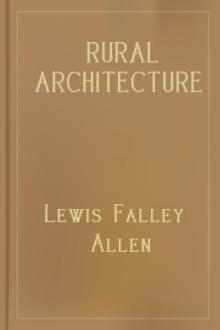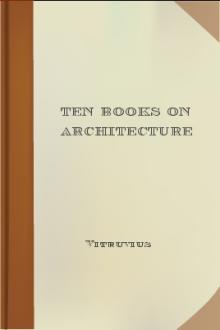Rural Architecture, Lewis Falley Allen [8 ebook reader .txt] 📗

- Author: Lewis Falley Allen
- Performer: -
Book online «Rural Architecture, Lewis Falley Allen [8 ebook reader .txt] 📗». Author Lewis Falley Allen
Such was the estate, and such the man who founded and enjoyed it sixty years ago; and many an equal estate, founded and occupied by equally valuable men, then existed, and still exist in all our older states; and if our private and public virtues are preserved, will ever exist in every state of our union. Such pictures, too, are forcible illustrations of the morals of correct building on the ample estates of many of our American planters and farmers. The mansion house, which is so graphically described, we saw but a short time before it was pulled down—then old, and hardly worth repairing, being built of wood, and of style something like this design of our own, bating the extent of veranda.
The cost of this house may be from $5000 to $8000, depending upon the material of which it is constructed, the degree of finish given to it, and the locality where it is built. All these circumstances are to be considered, and the estimates should be made by practical and experienced builders, who are competent judges in whatever appertains to it.
(173)
(174) 
FARM HOUSE. Pages 173-174.
larger view
Design VII.A Plantation House.—Another southern house is here presented, quite different in architectural design from the last, plain, unpretending, less ornate in its finish, as well as less expensive in construction. It may occupy a different site, in a hilly, wooded country of rougher surface, but equally becoming it, as the other would more fitly grace the level prairie, or spreading plain in the more showy luxury of its character.
This house stands 46×44 feet on the ground, two stories high, with a full length veranda, 10 feet wide in front, and a half length one above it, connecting with the main roof by an open gable, under which is a railed gallery for summer repose or recreation, or to enjoy the scenery upon which it may open. The roof is broad and overhanging, thoroughly sheltering the walls, and giving it a most protected, comfortable look. Covering half the rear is a lean-to, with shed roof, 16 feet wide, communicating with the servants' offices in the wing, the hall of which opens upon a low veranda on its front, and leading to the minor conveniences of the establishment. The main servants' building is 30×20 feet, one and a half stories high, with a roof in keeping with the main dwelling, and a chimney in the center. In rear of this is attached a wood-house, with a shed roof, thus sloping off, and giving it a reposed, quiet air from that point of view. A narrow porch, 23 feet long and 8 feet wide, also shades the remaining rear part of the main dwelling, opening on to the approach in rear.

GROUND PLAN
INTERIOR ARRANGEMENT.The front door opens into a hall 34 feet long and 10 feet wide, with a flight of stairs. On the left of this opens a parlor or dining-room, 22×18 feet, lighted by two windows in front and one on the side, and connecting with the dining-room beyond, which is 18×16 feet, with two small dining closets between. The dining-room has two windows opening on to the rear veranda. Under the cross flight of stairs in the hall, a partition separates it from the rear hall, into which is a door. On the right of the entrance hall is a library, 18×18 feet, lighted by three windows. At the farther end is a closet, and by the side of it a small entry leading into the nursery or family bedroom, 18×15 feet in size, which also has a corresponding closet with the library. On the rear of the nursery is a flight of back stairs opening from it. Under these stairs, at the other end, a door opens to another flight leading into the cellar below. A door also leads out from the nursery into the rear passage, to the offices; another door on the further side of the room opens into the rear hall of the house. The nursery should have two windows, but the drawing, by an error, gives only one. From this rear hall a door opens on the rear veranda, and another into the passage to the rear offices. This passage is six feet wide and 34 feet long, opening at its left end on to the veranda, and on the right, to the servants' porch, and from its rear side into three small rooms, 10 feet square each, the outer one of which may be a business room for the proprietor of the estate; the next, a store-room for family supplies; and the other a kitchen closet. Each of these is lighted by a window on the rear. A door also leads from the rear passage into the kitchen, 20×16 feet in area, with a window looking out in front and two others on the side and rear, and a door into the wood-house. In this is placed a large chimney for the cooking establishment, oven, &c., &c. A flight of stairs and partition divides this from the wash-room, which is 14×14 feet, with two windows in the side, and a door into the wood-house. This wood-house is open on two sides, and a water-closet is in the far corner. The small veranda, which is six feet wide, fronting the kitchen apartments, opens into the bath-room, 9×6 feet, into which the water is drawn from the kitchen boilers in the adjoining chimney. Still beyond this is the entrance to the water-closets, 6×5 feet.

CHAMBER PLAN
The chamber plan is simple, and will be readily comprehended. If more rooms are desirable, they can be cut off from the larger ones. A flight of garret stairs may also be put in the rear chamber hall. The main hall of the chambers, in connection with the upper veranda, may be made a delightful resort for the summer, where the leisure hours of the family may be passed in view of the scenery which the house may command, and thus made one of its most attractive features.
MISCELLANEOUS.We have given less veranda to this house than to the last, because its style does not require it, and it is a cheaper and less pains-taking establishment throughout, although, perhaps, quite as convenient in its arrangement as the other. The veranda may, however, be continued round the two ends of the house, if required. A screen, or belt of privet, or low evergreens may be planted in a circular form from the front right-hand corner of the dwelling, to the corresponding corner of the rear offices, enclosing a clothes drying yard, and cutting them off from too sightly an exposure from the lawn in front. The opposite end of the house, which may be termed its business front, may open to the every-day approach to the house, and be treated as convenience may determine.
For the tree decoration of this establishment, evergreens may come in for a share of attraction. Their conical, tapering points will correspond well with its general architecture, and add strikingly to its effect; otherwise the remarks already given on the subject of park and lawn plantation will suffice. As, however, in the position where this establishment is supposed to be erected, land is plenty, ample area should be appropriated to its convenience, and no pinched or parsimonious spirit should detract from giving it the fullest effect in an allowance of ground. Nor need the ground devoted to such purposes be at all lost, or unappropriated; various uses can be made of it, yielding both pleasure and profit, to which a future chapter will refer; and it is one of the chief pleasures of retired residence to cultivate, in the right place, such incidental objects of interest as tend to gratify, as well as to instruct, in whatever appertains to the elevation of our thoughts, and the improvement of our condition. All these, in their place, should be drawn about our dwellings, to render them as agreeable and attractive as our ingenuity and labor may command.
LAWNS, GROUNDS, PARKS, AND WOODS.Having essayed to instruct our agricultural friends in the proper modes of erecting their houses, and providing for their convenient accommodation within them, a few remarks may be pardoned touching such collateral subjects of embellishment as may be connected with the farm residence in the way of plantations and grounds in their immediate vicinity.
We are well aware that small farms do not permit any considerable appropriation of ground to waste purposes, as such spots are usually called which are occupied with wood, or the shade of open trees, near the dwelling. But no dwelling can be complete in all its appointments without trees in its immediate vicinity. This subject has perhaps been sufficiently discussed in preceding chapters; yet, as a closing course of remark upon what a farm house, greater or less in extent, should be in the amount of shade given to it, a further suggestion or two may be permitted. There are, in almost all places, in the vicinity of the dwelling, portions of ground which can be appropriated to forest trees without detriment to other economical uses, if applied in the proper way. Any one who passes along a high road and discovers the farm house, seated on the margin or in the immediate vicinity of a pleasant grove, is immediately struck with the peculiarly rural and picturesque air which it presents, and thinks to himself that he should love such a spot for his own home, without reflecting that he might equally as well create one of the same character. Sites already occupied, where different dispositions are made of contiguous ground, may not admit of like advantages; and such are to be continued in their present arrangement, with such course of improvement as their circumstances will admit. But to such as are about to select the sites of their future homes, it is important to study what can best embellish them in the most effective shade and ornament.
In the immediate vicinity of our large towns and cities it is seldom possible to appropriate any considerable breadth of land to ornamental purposes, excepting rough and unsightly waste ground, more or less occupied with rock or swamp; or plainer tracts, so sterile as to be comparatively worthless for cultivation. Such grounds, too, often lie bare of wood, and require planting, and a course of years to cover them with trees, even if the proprietor is willing, or desirous to devote them to such purpose. Still, there are vast sections of our country where to economize land is not important, and a mixed occupation of it to both ornament and profit may be indulged





Comments (0)